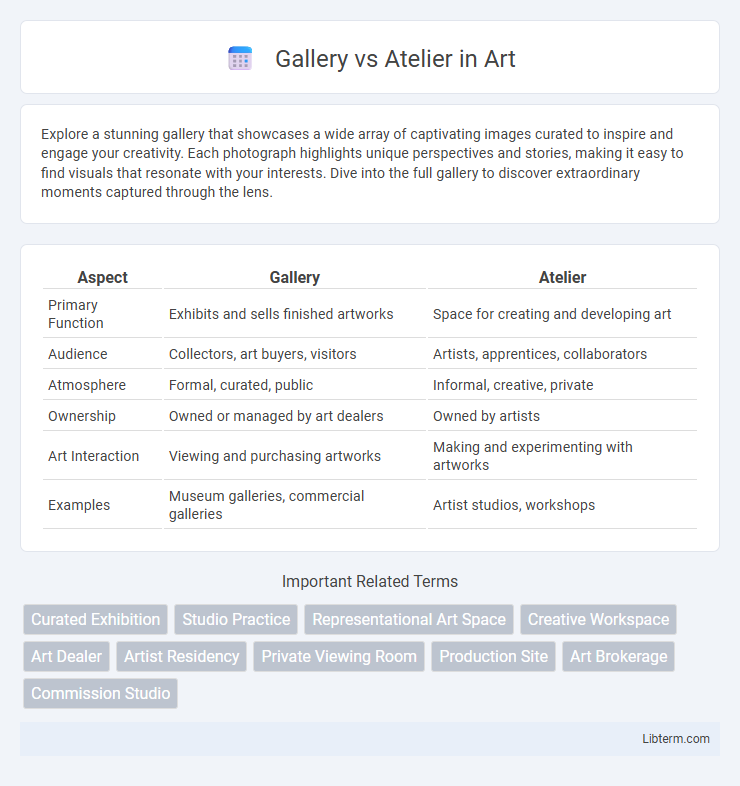Explore a stunning gallery that showcases a wide array of captivating images curated to inspire and engage your creativity. Each photograph highlights unique perspectives and stories, making it easy to find visuals that resonate with your interests. Dive into the full gallery to discover extraordinary moments captured through the lens.
Table of Comparison
| Aspect | Gallery | Atelier |
|---|---|---|
| Primary Function | Exhibits and sells finished artworks | Space for creating and developing art |
| Audience | Collectors, art buyers, visitors | Artists, apprentices, collaborators |
| Atmosphere | Formal, curated, public | Informal, creative, private |
| Ownership | Owned or managed by art dealers | Owned by artists |
| Art Interaction | Viewing and purchasing artworks | Making and experimenting with artworks |
| Examples | Museum galleries, commercial galleries | Artist studios, workshops |
Defining a Gallery: Purpose and Function
A gallery serves as a curated space for exhibiting and selling artworks, emphasizing public access and commercial transactions. It functions to promote artists, engage art collectors, and foster cultural exchange through organized exhibitions and events. The gallery's purpose centers on art presentation, market facilitation, and enhancing visibility within the art community.
Understanding an Atelier: Origins and Role
An atelier is traditionally a workshop or studio where artists create and refine their work, originating from the French word meaning "workshop." Unlike galleries that primarily focus on exhibiting and selling art, ateliers emphasize the creative process, providing artists with a dedicated space for experimentation and craftsmanship. Historically, ateliers served as collaborative environments where masters trained apprentices, fostering artistic skills and innovation.
Historical Evolution of Galleries and Ateliers
Galleries originated in the Renaissance as spaces for public art display and patronage, evolving into commercial hubs for artists and collectors by the 19th century. Ateliers, rooted in the academic art tradition, served as workshops where masters trained apprentices in classical techniques, emphasizing skill development and master-apprentice relationships. Over time, galleries shifted towards curatorial innovation and market dynamics, while ateliers retained their role in artistic education and craftsmanship preservation.
Spaces for Art Creation: Atelier Dynamics
An atelier serves as a dedicated workspace where artists immerse in the creative process, offering tailored environments with natural light, specialized tools, and personalized setups to enhance artistic productivity. In contrast, galleries prioritize exhibition space, providing curated environments designed to showcase finished artworks to the public or collectors rather than facilitate creation. The dynamic of an atelier centers on artistic experimentation and development, fostering innovation through a functional and flexible space tailored to the artist's workflow.
Spaces for Art Exhibition: Gallery Dynamics
Galleries provide curated spaces designed to showcase diverse artworks, emphasizing visitor engagement through controlled lighting and layout for optimal viewing experiences. In contrast, ateliers serve as creative studios where artists develop their work, often doubling as intimate exhibition spaces but prioritizing creation over presentation. Gallery dynamics revolve around professional presentation and public access, while ateliers focus on artistic process and personalized, often limited, audience interactions.
Artist Representation: Gallery vs Atelier
Galleries typically represent artists by promoting their work to collectors, organizing exhibitions, and managing sales, serving as intermediaries between artists and the market. Ateliers focus primarily on the creation process, providing artists with dedicated studio space, tools, and mentorship without commercial representation. While galleries prioritize market exposure and sales, ateliers emphasize artistic development and craftsmanship.
Audience Engagement in Galleries and Ateliers
Galleries primarily engage a broad audience through curated exhibitions, art openings, and public events, fostering a dynamic environment that encourages social interaction and art appreciation. Ateliers focus on intimate, hands-on experiences by allowing visitors to observe or participate in the artistic process, creating a deeper personal connection between the artist and audience. Audience engagement in galleries emphasizes visual consumption and community involvement, while ateliers prioritize educational interaction and creative collaboration.
Commercial Aspects: Selling Art in Galleries vs Ateliers
Galleries offer artists broader market exposure and access to established collector networks, enhancing sales potential through curated exhibitions and professional marketing. Ateliers provide a more intimate buying experience, allowing direct negotiation with collectors and fostering personalized relationships that can lead to customized commissions. While galleries typically handle promotion and transaction logistics, ateliers enable artists to retain greater control over pricing and sales conditions, impacting profit margins differently.
Collaborative Opportunities: Atelier Communities vs Gallery Networks
Atelier communities foster hands-on collaboration and direct artist-to-artist engagement, creating dynamic spaces for creative experimentation and skill-sharing. Gallery networks primarily offer exposure and market access, connecting artists with collectors, critics, and a broader audience through curated exhibitions. The atelier model emphasizes creative development and peer mentorship, while galleries focus on promotion, sales, and brand-building within the art ecosystem.
Choosing the Right Space: Artists’ Perspectives
Artists often select galleries to showcase their work for wider public exposure, professional curation, and sales potential, benefiting from the structured environment and established audience. Ateliers provide creative privacy and flexibility, allowing artists to experiment and develop their techniques without commercial pressures. Choosing between a gallery and an atelier depends on an artist's career goals, preferred working style, and the balance between exposure and creative freedom.
Gallery Infographic

 libterm.com
libterm.com